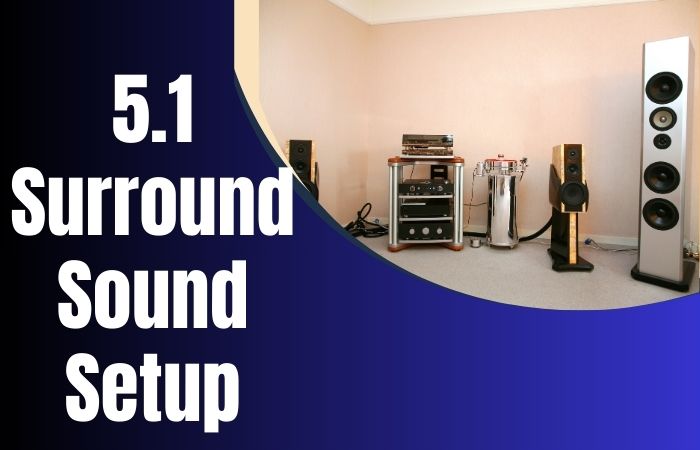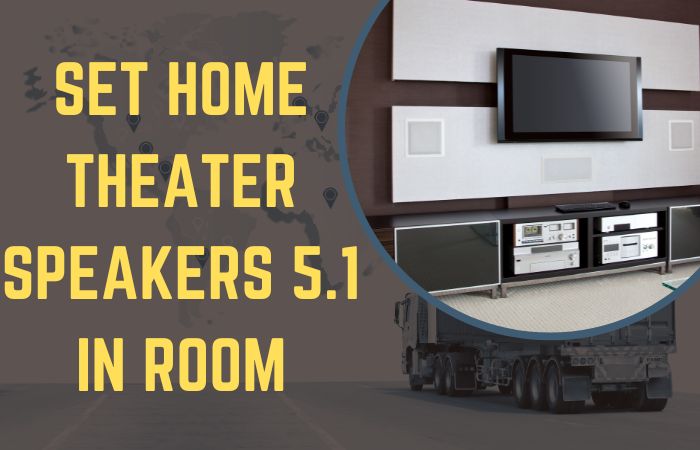Transforming your living space into a cinematic sanctuary is an endeavor that transcends the ordinary realm of home improvement. To embark upon the journey of “How to Install A Home Theater System” is to embrace a symphony of sights and sounds that will enrapture your senses, a tapestry of technological wizardry interwoven with artistry.
This guide is your beacon through the labyrinth of wires, speakers, screens, and mystique, shedding light on the esoteric landscape of audiovisual nirvana that is the home theater experience.
As we delve into this installation odyssey, be prepared to navigate a labyrinth of acoustical subtleties and visual enigmas, where each component dances in harmony, orchestrated by your command.
From the selection of avant-garde equipment that epitomizes modernity, to the intricacies of spatial calibration and acoustic resonance, we will traverse the untrodden path that is “Install A Home Theater System.”
The journey is not for the faint of heart, but with our guidance, you shall wield the power to transform your living room into a captivating cinema of dreams.
Join us as we unveil the mysteries of immersive audio, decipher the cryptic world of projectors and screens, and explore the intricate art of seating arrangement and soundstage calibration.
Welcome to a world where the ordinary is rendered obsolete, where the mundane is eclipsed by the extraordinary, and where the keyword “Install A Home Theater System” takes on a whole new dimension.
Buckle up, for you are about to embark on a journey of technological exuberance, where your home becomes a stage, and you sense the eager audience.
What is the Home Theater System?
A home theater system is a sanctuary of entertainment sophistication, where cutting-edge audio-visual equipment harmonizes to transmute your living space into a cinematic haven.
It encompasses a high-resolution display, immersive surround sound speakers, and an intelligent control hub, and often incorporates ambient lighting and acoustic enhancements.
In essence, it’s your personal portal to the world of movies, music, and gaming, offering a sensory journey that defies the ordinary and invites you to luxuriate in the extraordinary.
Install a Home Theater System: Step-by-Step Instruction 2024

The following is a step-by-step installation instructions for home theater systems:
Materials and Tools You’ll Need:
- Home theater system components (AV receiver, speakers, subwoofer, and a TV or projector)
- Speaker wires
- HDMI cables
- Audio cables (e.g., RCA or optical)
- Power strips or surge protectors
- Mounts or stands for speakers and TV (if required)
- A screwdriver and other basic hand tools
- A level and a stud finder (for wall mounting)
- Wire stripper and connectors (if needed)
Step-by-Step Install:
- Step 1: Before diving in, establish the layout of your home theater. Decide on the placement of your TV or projector screen, AV receiver, speakers, and other components.
- Step 2: Make sure you have access to power outlets and consider cable management.
- Step 3: Choose a central location for your AV receiver, usually near the TV or projector screen.
- Step 4: Connect the receiver to power.
- Step 5: Subsequently, link your source gadgets (Blu-ray player, game console, streaming device) to the AV receiver through HDMI cables for seamless connectivity.
- Step 6: Connect the receiver to the TV or projector using another HDMI cable.
- Step 7: Determine the ideal placement for your speakers. Common configurations include 5.1, 7.1, or even 9.1 setups.
- Step 8: Connect the speaker wires to the AV receiver’s speaker terminals. Be sure to connect the correct wires to the corresponding terminals (front, center, surround, subwoofer).
- Step 9: Run the speaker wires to each speaker location, securing them along walls or under rugs if necessary.
- Step 10: Connect the wires to the speakers using the appropriate connectors or terminals.
- Step 11: Place the subwoofer in a location that provides deep, even bass sound. Corner placement is often a good choice.
- Step 12: Integrate the subsonic apparatus with the AV receiver employing a specialized subwoofer cable, typically an RCA connector.
- Step 13: Power on your TV or projector, AV receiver, and source devices.
- Step 14: Use the AV receiver’s on-screen menu to configure your speaker settings, sound mode, and source inputs.
- Step 15: Adjust speaker levels to ensure balanced audio.
- Step 16: Set up any additional features, such as room calibration systems if your AV receiver has them.
- Step 17: Test your system with various sources to ensure audio and video are working correctly.
- Step 18: Tidy up your cable management by running cables along walls, using cable clips, or investing in cable sleeves.
- Step 19: Conceal wires where possible, especially if you have wall-mounted speakers or a wall-mounted TV.
- Step 20: Having meticulously configured your home theater ensemble, revel in its bespoke ambiance. Seize a connoisseur’s bowl of popcorn and plunge into a captivating odyssey through your favorite movies, shows, and playing games.
Best Home Theater Setup Service

The world of home theater setup services is a nuanced realm, where the technical choreography is executed with a deft touch. Here are the enchanting facets that such a service can offer:
- Acoustic Alchemy: These seasoned artisans of audiovisual enchantment possess an uncanny mastery over the science of sound. They discern the resonant nodes and auditory vistas of your space, intuitively placing speakers and subwoofers to conjure the perfect sonic ambiance.
- Visual Wizardry: The visual canvas is no less mesmerizing. With a painterly eye, these professionals position screens or projectors in a manner that captures the essence of cinematic grandeur, while ensuring optimal viewing angles, calibrated brightness, and pixel-perfect clarity.
- Hidden Infrastructure: The allure of a well-arranged home theater setup lies not just in what meets the eye but also in the concealed artistry. Concealing cables, wiring, and other unseemly infrastructure with an almost sorcerous grace, bestows a seamless aesthetic elegance upon your space.
- Technological Harmonization: These virtuosos of technology are adept at calibrating every component, be it the AV receiver, source devices, or remote controls. They weave a technological symphony where everything harmonizes seamlessly to cater to your entertainment whims.
- Customization and Optimization: One of the hallmarks of this service is its ability to tailor your home theater to your specific preferences. Whether it’s configuring surround sound for gaming, optimizing lighting to match the mood, or integrating smart home features, your home theater becomes uniquely yours.
- Future-Proofing: In a landscape where technology evolves at a relentless pace, these service providers ensure that your setup is ready for the future. They stay abreast of the latest advancements and integrate cutting-edge components, safeguarding your investment against obsolescence.
- Education and Empowerment: These maestros don’t just leave you with an enchanting setup but also bestow upon you the knowledge to operate and maintain it. It’s an educational encore, ensuring you’re in control of your cinematic symphony.
5.1 Surround Sound Speaker Placement

Crafting a 5.1 home theater setup diagram is akin to charting a visual symphony, where each component is meticulously positioned to orchestrate a harmonious acoustic and visual experience.
In this elaborate arrangement, five speakers and one subwoofer collaborate to envelop the audience in an immersive soundscape. Let’s delve into the creative composition of a 5.1 home theater setup diagram:
- AV Receiver: Positioned at the heart of the ensemble, the AV receiver serves as the epicenter of this auditory odyssey. Its role is to decode and amplify audio signals from various sources. Employing a novel interconnection, HDMI cables link the receiver to your audiovisual devices, allowing it to channel the digital symphony to your auditory and visual assets.
- TV or Screen: The focal point of this visual overture, the TV or screen, takes center stage on the wall or an entertainment center. The viewer is transported into the cinematic narrative as this screen springs to life, illuminated by the interconnected HDMI cable.
- Front Left and Right Speakers: Flanking the screen with purpose, the front left and right speakers possess an aura of authority. They disperse a dynamic soundscape, enriching dialogues and ambiance. The auditory realism they convey transcends the realm of ordinary sonic encounters.
- Center Speaker: Nestled below the screen, the center speaker serves as the vocal narrator of the narrative. Its positioning ensures that dialogues resonate with clarity, anchoring the audience in the heart of the storytelling.
- Surround Speakers (Rear Left and Right): Mounted strategically or seamlessly into the rear walls, the surround speakers imbue the space with an encompassing atmosphere. Their ethereal soundscape manipulates the auditory dimension, allowing sounds to swirl and envelop the audience, fostering an immersive experience.
- The Subwoofer: Positioned discreetly, the subwoofer takes the stage to underline the auditory narrative with the depth of resonant bass. Its role is to summon the rumbling thunder, seismic impacts, and the symphonic low-frequency reverberations that infuse scenes with palpable realism.
- AV Remote: In the viewer’s hand, the AV remote acts as the virtuoso conductor, orchestrating the volume, sources, and audio settings. Its role is to fine-tune the performance, ensuring that the acoustic and visual elements remain in harmonious balance.
- Cable Concealment and Furniture: In this theatrical design, cable concealment plays a crucial role in maintaining visual elegance. Employ cable sleeves or wall-mounted channels to ensconce the cables discreetly, ensuring the aesthetic integrity of the setting.
How to Set Up Surround Sound on TV

Setting up surround sound on your TV can greatly enhance your audio experience when watching movies, playing video games, or enjoying music. To achieve this, follow these steps:
Materials and Tools You’ll Need:
- Surround sound system (receiver and speakers)
- HDMI cables (for best audio quality)
- Speaker wires
- TV remote control
- AV receiver remote control
- Power strips or surge protectors
- Ensure your surround sound system is ready for setup. Assemble the quintessential setup with an AV receiver, front speakers, center speakers, surround speakers, and a subwoofer. Assure that each component is seamlessly connected and aglow with power.
- Find the HDMI Out port on your AV receiver and connect it to one of the HDMI In ports on your TV. This will transmit both audio and video signals.
- Power on both the AV receiver and the TV.
- Using your TV remote control, access the TV’s settings menu.
- Navigate to the audio settings. This may be labeled as “Audio,” “Sound,” or “Settings.”
- Select the audio output setting and choose “External Speakers” or “Home Theater.”
- Ensure that the TV’s internal speakers are turned off to let the surround sound system handle the audio.
- Place the front speakers on either side of your TV. Connect the speaker wires to the Front Speaker terminals on the AV receiver and to the corresponding terminals on the speakers.
- Position the center speaker above or below the TV. Connect it to the Center Speaker terminals on the AV receiver.
- Place the surround speakers behind or to the sides of your seating area. Connect them to the Surround Speaker terminals on the AV receiver.
- Position the subwoofer in an ideal location (often near a corner for deep bass). Connect it to the Subwoofer output on the AV receiver.
- Most AV receivers come with an automatic speaker calibration system. This function helps set speaker distances, levels, and other audio parameters for optimal performance. Consult your receiver’s manual to run the calibration.
- Employ the AV receiver remote control to designate the desired audio source for playback. This may encompass a DVD player, gaming console, streaming device, or any alternative source interfaced with your AV receiver.
- With meticulous setup complete, revel in the euphonic ambiance bestowed by your impeccably configured surround sound system. Adjust the volume, and if needed, make further adjustments through the AV receiver’s settings to suit your preferences.
5.1 Surround Sound Setup

A 5.1 surround sound setup is like an orchestral masterpiece for your auditory senses. It is a configuration that marries technology and acoustics to deliver an immersive audio experience.
Comprising five speakers and one subwoofer, this arrangement creates a multisensory symphony that enchants your living space. Let’s explore the intricacies of this sonic tapestry:
- AV Receiver: At the nucleus of the setup resides the AV receiver, the maestro that conducts the auditory ballet. This central hub deciphers and amplifies audio signals from your diverse multimedia sources. Through an intricate interplay of HDMI cables, it connects your ensemble to the digital world, orchestrating a harmonious fusion of sound and vision.
- TV or Screen: In this audiovisual narrative, the TV or screen is the luminary, poised on a grand stage, illuminated by the HDMI connection to the AV receiver. It is the portal through which the visual symphony unfolds, complemented by the immersive aural tapestry.
- Front Left and Right Speakers: These speakers are the foundation, flanking the screen, much like structural pillars. Positioned at an optimal ear-level distance from your viewing area, they channel audio intricacies, rendering depth, clarity, and dimensionality to the soundscape.
- Center Speaker: Resting majestically above or below the screen, the center speaker lends its vocal prowess to storytelling. It accentuates dialogue, ensuring that characters’ voices resonate with perfect clarity and precision.
- Surround Speakers (Rear Left and Right): Crafted to envelop your space in a cocoon of sound, the surround speakers are positioned artfully behind or to the sides of your seating arena. They generate an immersive atmosphere, allowing sounds to dance around you, captivating your senses.
- Subwoofer: The subwoofer, often discreetly stationed, contributes to the foundation of this audio spectacle. It adds a tactile and visceral quality to the performance, summoning deep bass, seismic impacts, and resounding low-frequency reverberations.
- AV Remote Control: Empowering the viewer, the AV remote control becomes the maestro’s wand. It orchestrates volume, source selection, and audio settings, allowing you to fine-tune the performance and relish the sensory symphony at your command.
- Cable Concealment and Room Aesthetics: To preserve the symphony’s visual elegance, conceal speaker wires along baseboards, beneath rugs, or within wall-mounted channels. This endeavor in cable concealment ensures the room’s aesthetics harmonize with the auditory masterpiece.
Best Settings for 5.1 Surround Sound

Refining parameters for your 5.1 surround sound system is vital for an immersive auditory journey in movies, gaming, or music. Optimal settings hinge on equipment nuances and preferences, but here are foundational directives to initiate your customization and elevate your audio experience:
- Speaker Calibration: Most modern AV receivers include an automatic speaker calibration system, such as Audyssey or Yamaha’s YPAO. Use these systems to configure your speakers, and set distances, levels, and equalization. This ensures that sound is balanced, and the audio experience is tailored to your room’s acoustics.
- Speaker Placement: Position your speakers correctly. The front left and right speakers should be at ear level, equidistant from the screen and you. The center speaker should be directly above or below the screen. The surround speakers should be placed slightly behind and to the sides of your seating area. The subwoofer can be placed anywhere in the room, but corners often provide enhanced bass response.
- Crossover Settings: Set the crossover frequency for your speakers in the AV receiver’s menu. The crossover determines at what point low frequencies are redirected to the subwoofer. A typical starting point is around 80Hz. Adjust this based on your specific speakers and room acoustics.
- Speaker Levels: Use your AV receiver’s calibration system to balance the levels of each speaker. However, you may still need to make manual adjustments. Ensure that each speaker produces sound at the same volume when tested.
- Listening Modes: Many AV receivers offer various listening modes such as “Dolby Digital,” “DTS,” or “Stereo.” Choose a mode that suits the content you’re watching. For movies, consider using a surround sound mode, while stereo may be preferable for music.
- Bass Management: In your AV receiver settings, enable bass management. This ensures that low-frequency sounds are sent to the subwoofer. Adjust the subwoofer volume to achieve a balance that complements the rest of the speakers.
- Room Acoustics: Consider the acoustics of your room. Soft furnishings, curtains, and carpets can help dampen sound reflections, improving the audio experience.
- Source Devices: Validate concordance in audio output configurations on source devices (e.g., Blu-ray player, gaming console, streaming device) with the aptitudes of your AV receiver. Certain devices may proffer the option to elect the audio format (e.g., Dolby Digital or DTS).
- Test and Adjust: After calibrating your system, watch movies or listen to music to assess the sound quality. Make further adjustments as needed, such as tweaking the equalization or choosing different listening modes based on the content.
How to Set Home Theater Speakers 5.1 in Room

Setting up a 5.1 home theater speaker system in a room requires careful placement to achieve optimal audio performance. This configuration includes five speakers and one subwoofer, which together create a surround sound experience. Here’s how to set up your 5.1 home theater speakers in a room:
Materials and Tools You’ll Need:
- 5.1 home theater speaker system (front left, front right, center, rear left, rear right speakers, and a subwoofer)
- Speaker wires (ensure they are long enough to reach the desired locations)
- A receiver or amplifier
- Measuring tape
- Optional: Speaker stands or wall mounts
- A level and stud finder (for wall mounting)
- Wire stripper and connectors (if needed)
- Front Left and Right Speakers: Place these speakers on either side of your TV or projection screen, ideally at ear level when seated. They should be equidistant from the screen and you, forming an equilateral triangle.
- Center Speaker: Position the center speaker directly above or below your TV screen, ensuring it’s at ear level when seated. This speaker plays a crucial role in dialogue clarity.
- Rear Left and Right Speakers (Surround Speakers): These speakers should be positioned behind your viewing area. You can place them on speaker stands or wall-mount them slightly above ear level when seated, directed towards the seating area.
- Subwoofer: The subwoofer delivers low-frequency (bass) effects. It’s less location-dependent and can be placed anywhere in the room, but corners often provide enhanced bass response.
- Run Speaker Wires: Run speaker wires from the speakers to your AV receiver or amplifier. Conceal the wires along the baseboards, under rugs, or using wire channels to maintain a neat appearance. Be cautious when hiding wires to avoid tripping hazards.
- Connect Speakers to the Receiver: Connect the speaker wires to the corresponding terminals on your AV receiver. Ensure you connect the correct speaker wires to the appropriate channels (front left, front right, center, rear left, rear right) on the receiver.
- Calibrate Your System: Most AV receivers come with a calibration system that sets speaker distances, levels, and other audio parameters automatically. Consult your receiver’s manual to initiate and complete the calibration process for optimal audio performance.
- Test Your System: Once the calibration is complete, test your 5.1 home theater system with a movie, music, or other content that utilizes surround sound. Ensure that each speaker is producing sound, and the audio balance is to your liking.
- Fine-Tuning: You may need to fine-tune the speaker levels and settings on your AV receiver to suit your preferences. Adjust settings for bass, treble, and surround modes as needed.
With your 5.1 home theater speaker system correctly set up, you can now enjoy immersive audio that envelops you in the rich sound of your favorite movies, games, and music.
Pros and Cons of Install a Home Theater System
Pros:
- Immersive Entertainment: With the help of the installation of a home theater system, you can immerse yourself in the intriguing and immersive worlds of games, music, and movies like never before.
- Cinematic Quality: With high-definition displays and surround sound, it replicates the cinematic quality, delivering crisp visuals and 3D audio that rival the movie theater.
- Customization: You have the flexibility to tailor your setup to your preferences, from screen size to speaker placement, creating a unique viewing and listening environment.
- Convenience: Home theaters eliminate the need for outings to crowded theaters, providing the convenience of enjoying your favorite content in the comfort of your own home.
- Multi-Purpose: A home theater system adds versatility to your living area by acting as a center for gaming, streaming, and even presentations in addition to movies.
Cons:
- Costly Investment: High-quality home theater systems can be expensive, including the cost of equipment, installation, and acoustic treatments.
- Space Requirements: A full-fledged home theater may demand a significant amount of space, which might not be feasible for smaller living areas.
- Complex Setup: The setup and calibration of a home theater system can be complex, requiring technical expertise or professional installation.
- Maintenance: Regular maintenance and updates may be necessary to ensure that the equipment and software remain in optimal condition, incurring additional costs and efforts.
- Noise Pollution: The immersive sound of a home theater can be a source of disturbance for neighbors or other household members if not properly soundproofed.
Bottom Line
In the intricate tapestry of metamorphosing your living space into a cinematic haven, our exploration of “How to Install A Home Theater System” culminates inspiringly. Empowered by our guide, you’ve deftly navigated the labyrinth of audiovisual intricacies, emerging as the conductor of your immersive symphony.
Your home now possesses the alchemy to transport you to ethereal realms, whether via an epic blockbuster or a tranquil documentary.
In the realm of home theaters, your domain serves as a portal to extraordinary entertainment, and the keyword “Install A Home Theater System” acts as a gateway to this captivating expanse.
It’s time to embrace the extraordinary, celebrate the uncommon, and revel in the enchantment of your personal cinematic sanctuary.
Your journey doesn’t terminate here; it unfurls with every film, every game, and every musical note resonating through your extraordinary home theater system.
People Also Ask
What do you need to set up a home theater system?
When need a home theater setup, you’ll need a television or projector, an AV receiver, speakers, a subwoofer, source devices, cables, remote control, seating, and with proper room arrangement.
How can I connect a home theater system?
Connect your selected devices to the AV receiver using HDMI cables, and carefully connect the receiver to your TV or projector. Position and connect the speakers, set up the subwoofer, power everything on, configure settings, and calibrate for optimal audio and video.
Does a home theater need an amplifier?
A home theater typically includes an AV receiver that functions as an amplifier. For most setups, an external amplifier is not necessary.
How do I set up a home theater on my TV?
To set up a home theater on your TV, connect source devices to the AV receiver, link the receiver to your TV, position and connect speakers, set up the subwoofer, power on the system, configure settings, and calibrate for the best audio-visual experience.






